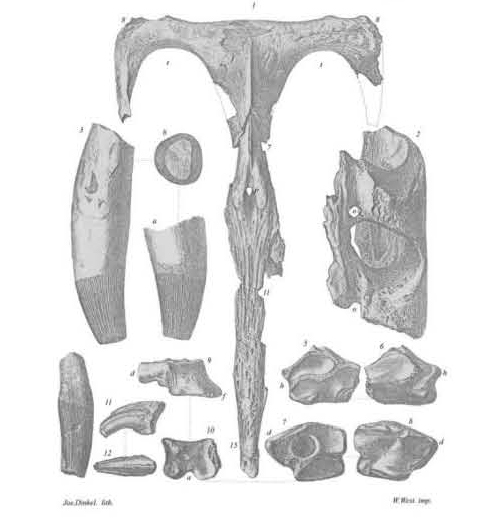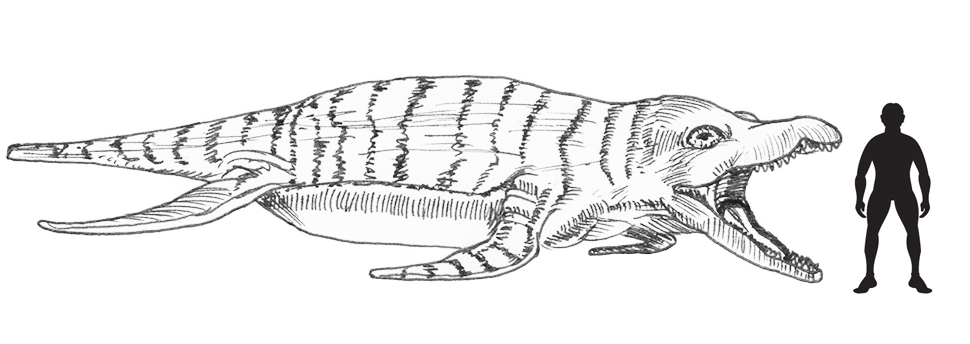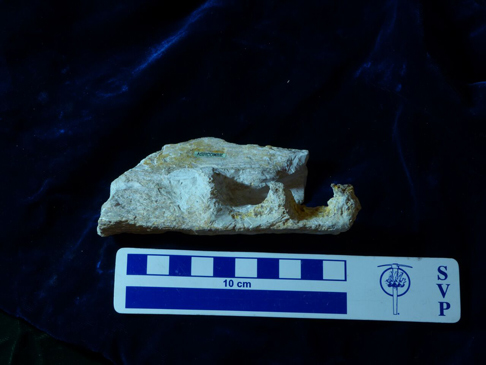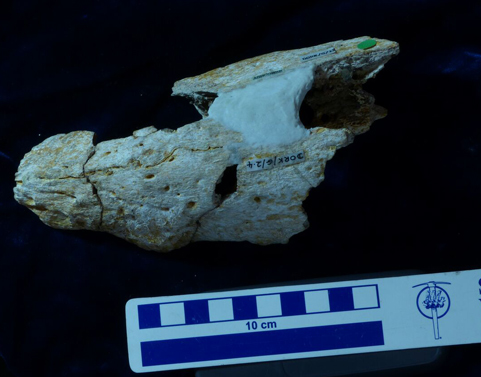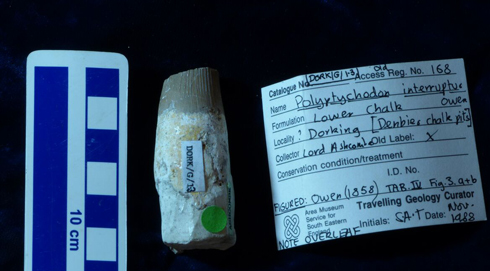Rare Pliosaur Skull Links Dorking to Kansas
Pliosaur Skull Links Dorking to Kansas
For much of the later stages of the Cretaceous, the area that is now known as the British Isles lay underwater. Bad news if you are searching for evidence of terrestrial dinosaurs, however, the limestones and chalk deposits associated with southern England can still yield some exciting surprises for vertebrate palaeontologists. Take for example, the research of Dr Roger Benson (University of Oxford, Dept. of Earth Sciences), who has been examining the fragmentary remains of pliosaurs associated with the lithostratigraphic unit of strata known as the Chalk Group.
Analysis of a Pliosaur Skull
Dr Benson’s analysis of a pliosaur specimen housed in the collection of the Dorking Museum and Heritage Centre reveals that the fossils may have been misidentified, by none other than Sir Richard Owen, the anatomist who is credited with the naming of the Order Dinosauria.
An Illustration from the Original 1858 Monograph by Richard Owen
Picture credit: The Pterosaur Database/Dr R Benson (Supplement (No. III) to the Monograph on the Fossil Reptilia of the Cretaceous Formations: 1858).
The illustration above shows some of the skull fossils and teeth described by Richard Owen as the pliosaur Polyptychodon interruptus. The smaller illustrations to be found in the lower portion of the picture depict various pterosaur fossils.
What are Pliosaurs?
Pliosaurs, or those animals that make up the Pliosauridae clade, are an extinct group of marine reptiles, that along with the long-necked plesiosaurs make up the Order Plesiosauria. Pliosaurs tend have short necks and large, broad skulls. They have a worldwide fossil distribution and they first appeared during the Early Jurassic with many of these reptiles evolving into giants that specialised in hunting other marine vertebrates like today’s killer whales. Famous prehistoric animals such as Liopleurodon and the Australian Kronosaurus are examples of pliosaurs.
An Illustration of a Typical Pliosaur (Pliosaurus brachydeirus)
Picture credit: Everything Dinosaur
Having dominated marine environments for the best part of a 100 million years, with many forms becoming apex predators, towards the early Late Cretaceous remains of these reptiles disappear from the fossil record. Around ninety million years or so ago, these sea monsters died out. Why the pliosaurs became extinct remains a mystery.
Studying Fossil Material
It is important for palaeontologists to gain as much information as they can from existing fossil specimens. Perhaps, thanks to the careful research of Dr Benson and the presence of many fine fossil collections held in regional museums, one day scientists may have a more complete understanding of how these great reptiles evolved and radiated out into so many forms dominating a number of marine palaeoenvironments. Scientists might even be able to provide information on why these leviathans went into decline and died out.
The Dorking Pliosaur Specimen
During the early part of the 19th century a number of fossils of marine reptiles were collected by amateur geologists and naturalists. One such collection, which had been the amassed by the first Baron Ashcombe was donated to the Dorking Museum in 1948 by the first Baron’s grandson. Amongst the specimens donated was the relatively complete skull of a pliosaur which had been discovered sometime in the 1850s.
The first Baron Ashcombe had used his influence to invite none other than Richard Owen to examine the fossil collection. Richard Owen, who was later to help found the Natural History Museum (London), described this skull as an example of the pliosaur Polyptychodon interruptus (Po-lip-tie-ko-don in-terr-rupt-us), the name means ” broken apart fin shaped tooth”.
A Pliosaur Skull
When Dr Benson visited the Dorking Museum and Heritage Centre to inspect the skull material, he noted a number of similarities between this fossil specimen and the fossils of another pliosaur, known from North America. In addition, Dr Benson’s study revealed that most other fossils of Polyptychodon species come from rocks that are much older than the ones found in the chalk pits in this part of Surrey (southern England). This casts doubt over the original conclusions drawn by the celebrated anatomist Richard Owen. It seems that the Dorking specimen may represent a type of pliosaur whose fossils are associated with Kansas.
A Fragment of the Lower Jaw
Picture credit: Dr Roger Benson (Oxford University)
Affinities with Brachauchenius
Although Owen thought the Dorking specimen belonged to Polyptychodon the shape of the skull (morphology) suggests to Dr Benson that this specimen may actual be another type of pliosaur altogether. Dr Benson concludes that the Dorking specimen shares many similarities with a pliosaur known as Brachauchenius (Brak-ow-ken-ee-us) whose fossils are mainly associated with the Western Interior Seaway of the early Late Cretaceous that covered most of the land that is now known as the United States.
According to Dr Benson’s research, most other specimens assigned to the Polyptychodon genus are around 115 million years old (Aptian age of the Cretaceous), but the Dorking fossil material comes from much younger strata, rocks that date from around 90-95 million years ago (Cenomanian to Turonian age). This indicates that the pliosaur fossils within the collection of the Dorking Museum and Heritage Centre represents one of the last of the pliosaurs.
Part of the Lower Jaw Bone
Picture credit: Dr. Roger Benson (Oxford University)
Knowledge of the Pliosauridae
Our knowledge of the Pliosauridae has improved enormously since the time of Richard Owen, as has our knowledge of stratigraphy. These collections, many of which are housed in small regional museums can still have a very significant role in research, for example, in this instance, helping to build up a better picture of an ancient marine fauna.
Everything Dinosaur stocks a wide range of pliosaur and plesiosaur models: Sea Monsters and Marine Reptile Models.
The Museum’s Chairman, Nigel Arch, commenting on Dr Benson’s visit stated that it was:
“A good example of the value of our collections and the fact that we can always learn more. It is wonderful to think that the study of this specimen, found locally and collected by a local person, is still contributing to scientific knowledge today.”
A Pliosaur Tooth of P. interruptus
Picture credit: Dr Roger Benson (Oxford University)
Dr Benson put his research into context, explaining:
“Pliosaurs were giant marine reptiles that could swim across oceans, specimens like the Dorking pliosaur show that this is true because similar fossils are also found in America”.
The Importance of Regional Museums
Regional museums such as the the Dorking Museum and Heritage Centre house many fine specimens assisting in the preservation of an amazing geological and fossil record.
Research using some of the specimens from within these collections can help to shed light on the diversity and distribution of pliosaur genera. Who knows, perhaps locked away in some cabinet, part of the prized fossil collection of another regional museum may lay the fossilised bones of another mislabelled specimen, one that could provide clues as to the why the Pliosauridae became extinct.


